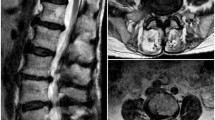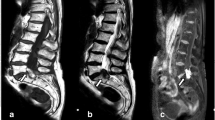Abstract
Background
Pseudomeningoceles most commonly occur due to prior trauma or surgery and are often located in the posterior paraspinous tissues. Here, we report a case of an intraosseous pseudomeningocele that mimicked an intra-osseous T2 hyperintense lesion in the L1 vertebral body.
Case description
A 64-year-old male presented with back, left lateral thigh and left knee pain lasting several months. He had no prior history of trauma or surgery. Radiographs of the lumbar spine showed mild levoscoliotic curvature of the lumbar spine, Baastrup’s changes between the spinous processes, multilevel degenerative disc disease and facet arthropathy. Magnetic resonance imaging (MRI) of the lumbar spine performed without intravenous contrast showed severe spinal canal stenosis from L1–L2 to L3–L4 and moderate spinal canal stenosis at L4–L5. MRI also showed a 2.5-cm T2 hyperintense lesion involving the posterior aspect of the L1 vertebral body, with questionable contiguity with cerebrospinal fluid. Computed tomography (CT) myelogram was performed instead of biopsy. CT myelogram showed contiguity of the lesion with the intrathecal contrast and a rent in the posterior longitudinal ligament and anterior dura consistent with an intraosseous pseudomeningocele. The patient opted for non-operative management of the pseudomeningocele and his lumbar stenosis due to medical comorbidities.
Conclusions
This case illustrates a rare case of an intra-osseous pseudomeningocele and highlights the importance of CT myelogram for diagnosis.



Similar content being viewed by others
References
Hyndman OR, Gerber WF (1946) Spinal extradural cysts, congenital and acquired. J Neurosurg 3(6):474–486
Hawk MW, Kim KD (2000) Review of spinal pseudomeningoceles and cerebrospinal fluid fistulas. Neurosurg Focus 9(1):1–8
Gandhoke GS, Hauptman JS, Salvetti DJ, Weiner GM, Panigrahy A, Yilmaz S, Pollack IF (2015) Transosseous cerebrospinal fluid fistula 14 years after Chiari decompression: presentation and management. J Neurosurg Pediatr 16:146–149
Couture D, Branch CL Jr (2003) Spinal pseudomeningoceles and cerebrospinal fluid fistulas. Neurosurg Focus 15(6):1–5
Swanson HS, Fincher EF (1947) Extradural arachnoidal cysts of traumatic origin. J Neurosurg 4(6):530–538
Paolini S, Ciappetta P, Piattella MC (2003) Intraspinous postlaminectomy pseudomeningocele. Eur Spine J 12:325–327
Shimazaki K, Nishida H, Harada Y, Hirohata K (1991) Late recurrence of spinal stenosis and claudication after laminectomy due to an ossified extradural pseudocyst. Spine 16(2):221–224
Teplick JG, Peyster RG, Teplick SK, Goodman LR, Haskin ME (1983) CT identification of postlaminectomy pseudomeningocele. AJR Am J Roentgenol 140:1203–1206
Schumacher HW, Wassmann H, Podlinski C (1988) Pseudomeningocele of the lumbar spine. Surg Neurol 29(1):77–78
Hadani M, Findler G, Knoler N, Tadmor R, Sahar A, Shacked I (1986) Entrapped lumbar nerve root in pseudomeningocele after laminectomy: report of three cases. Neurosurgery 19(3):405–407
Placantonakis DG, Lis E, Souweidane MM (2006) Intradiploic cerebrospinal fluid fistulas of iatrogenic origin. J Neurosurg (5 Suppl Pediatrics) 104:356–359
Giordano M, Di Rocco C (2016) Iatrogenic intradiploic cerebrospinal fluid collection. Childs Nerv Syst 32:787–790
Cook DA, Heiner JP, Breed AL (1989) Pseudomeningocele following spinal fracture. Clin Orthop Relat Res 247:74–78
Mahaney KB, Menezes AH (2014) Intradiploic occipital pseudomeningocele in a patient with remote history of surgical treatment of Chiari malformation. J Neurosurg Spine 21:769–772
Radcliff K, Morrison WB, Kepler C, Moore J, Sidhu GS, Gendelberg D, Miller L, Sonagli MA, Vaccaro AR (2016) Distinguishing pseudomeningocele, epidural hematoma, and postoperative infection on postoperative MRI. Clin Spine Surg 29(9):E471–E474
Author information
Authors and Affiliations
Corresponding authors
Ethics declarations
Conflict of interest
The authors declare that they have no conflicts of interest.
Rights and permissions
About this article
Cite this article
Rider-Longmaid, E., Huang, J., Sebro, R. et al. Intraosseous pseudomeningocele of the mobile spine: a case report and review of the literature. Eur Spine J 27 (Suppl 3), 472–476 (2018). https://doi.org/10.1007/s00586-018-5498-z
Received:
Revised:
Accepted:
Published:
Issue Date:
DOI: https://doi.org/10.1007/s00586-018-5498-z




